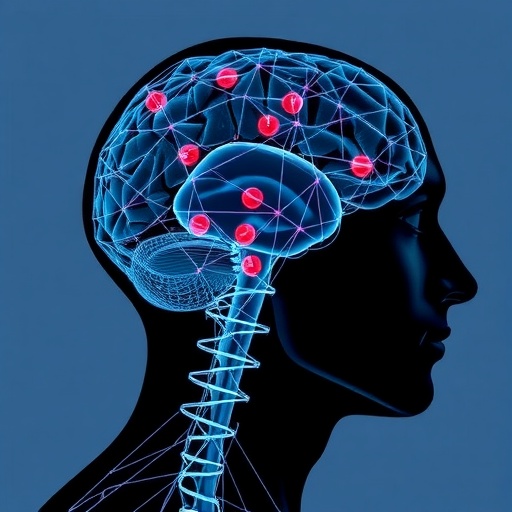In an age where artificial intelligence is rapidly transforming the landscape of medical diagnostics, a groundbreaking study has surfaced, promising to revolutionize the way Parkinson’s disease (PD) motor symptoms are identified and evaluated. Presented by An, Su, Yang, and colleagues in their latest publication in npj Parkinson’s Disease, this research unlocks the potential of advanced neural network architectures to enhance disease monitoring and pharmacological efficacy assessment, two critical elements in managing a complex neurodegenerative disorder like Parkinson’s.
The study introduces a novel framework powered by spatiotemporal hypergraph self-attention neural networks. This cutting-edge approach transcends traditional diagnostic tools by capturing intricate spatiotemporal relationships within monitored motor symptoms. Parkinson’s disease, characterized by tremors, rigidity, bradykinesia, and postural instability, often presents diagnostic challenges due to its heterogeneous manifestation. The new methodology aims to dissect these complexities by leveraging higher-dimensional graph structures, thus modeling symptom progression more precisely and dynamically.
Central to this innovation is the concept of hypergraphs—a generalized form of graphs where an edge can connect multiple nodes simultaneously. Unlike conventional graphs that consider pairwise connections, hypergraphs can encapsulate multifaceted interactions, mirroring the simultaneous and overlapping nature of motor symptom occurrences in Parkinson’s patients. This distinction allows for a richer, more holistic representation of the disease’s motor symptomatology, paving the way for automated systems that can interpret evolving symptom patterns with heightened sensitivity.
The self-attention mechanism embedded within the neural network architecture is instrumental in dynamically highlighting the most critical features from complex datasets. Originating from natural language processing, self-attention essentially enables the model to weigh the importance of different components in sequence data. In the context of Parkinson’s disease motor symptoms, it means the system can prioritize specific motor events or symptoms over time, capturing subtle variations that might elude human clinicians or conventional algorithms.
Moreover, the framework nurtures a profound temporal understanding by integrating sequential data points, which is essential given the fluctuating and progressive nature of PD symptoms. Temporal aspects often hold clues about disease trajectory and treatment responsiveness. Traditional assessments rely heavily on sporadic clinical evaluations, limiting the granularity of symptom monitoring. This neural network, by continuously assimilating motor symptom data over time, fosters real-time and longitudinal disease assessment, thus opening a window for personalized therapeutic strategies.
To evaluate the clinical relevance of their model, the researchers employed data from multifaceted sensor arrays capturing patient motor activity alongside pharmacological treatment records. This comprehensive data collection spanning motion sensors and medication intake was ideal to test the framework’s proficiency in both identifying motor impairments and quantifying drug efficacy. The neural network adeptly distinguished between symptom states, demonstrating an impressive capability to not only detect motor anomalies but also track pharmacological impacts with objective precision.
One of the monumental advantages of this AI-driven method lies in its potential to serve as an unbiased and continuous monitoring tool. Unlike traditional assessments, which are often subjective and episodic, this approach provides consistent surveillance of motor symptoms. Such consistency reduces diagnostic variability and could significantly improve clinical decision-making for neurologists managing Parkinson’s disease, ultimately contributing to better patient outcomes.
The model’s performance was benchmarked against several existing algorithms, where it showed superior sensitivity and specificity in detecting and classifying PD-specific motor symptoms. It managed to decode the intricacies of bradykinesia and tremor dynamics across varying stages of the disease, highlighting its versatility and robustness. This also underscores an exciting opportunity for integrating AI frameworks into wearable devices for unobtrusive, continuous health monitoring.
Beyond the immediate clinical sphere, this research demonstrates the burgeoning role of hypergraph-based machine learning applications in biomedical sciences. While hypergraphs have predominantly been explored in theoretical domains, their deployment in practical, patient-centered scenarios exemplifies a pivotal convergence of computational innovation and medical necessity. This interdisciplinary approach is a testament to how emerging technologies are reshaping healthcare paradigms.
Pharmacological efficacy assessment, a component frequently hampered by heterogeneous patient responses and subjective reporting, found a new ally in this methodology. By quantifying the influence of medications on motor parameters with fine temporal granularity, the framework can potentially guide dosage adjustments and timing. These insights are vital, especially considering the narrow therapeutic window and variable response profiles in Parkinson’s pharmacotherapy.
The scientific community has long recognized the need for more objective and detailed monitoring systems for PD. Historically, movement disorder scales like the Unified Parkinson’s Disease Rating Scale (UPDRS) have been the cornerstone for motor symptom evaluation, albeit limited by their dependency on clinician expertise and single time-point assessments. The hypergraph self-attention model offers an alternative that is data-driven, reducing observer bias and amplifying the scale of monitoring beyond conventional clinical confines.
This study also shines light on the importance of integrating multimodal data into disease characterization. Parkinson’s motor symptoms do not exist in isolation but interact within complex neural circuitry and external environmental factors. The hypergraph framework’s ability to coalesce diverse streams of information—spatial, temporal, and pharmacological—into a unified representation signals a transformational step toward comprehensive disease profiling.
While the promise of this technology is tremendous, the authors acknowledge challenges ahead. Translating such computationally intensive models into real-world clinical tools demands considerations around computational resources, data privacy, and user-friendliness. Furthermore, widespread adoption will require extensive validation across varied demographic cohorts and integration within existing healthcare infrastructures.
Nonetheless, the potential impact of this work is profound. By transcending the limitations of current diagnostic instruments, it offers a pathway toward personalized medicine in Parkinson’s disease, where treatments can be tailored and dynamically adjusted based on nuanced symptom monitoring. This personalized approach is the essence of future healthcare and echoes the broader movement towards precision neurology.
The fusion of spatiotemporal modeling with hypergraph theory and self-attention mechanisms also presents a framework adaptable to other neurodegenerative and motor disorders with complex phenotypes. Diseases like multiple sclerosis, Huntington’s, or amyotrophic lateral sclerosis, which also exhibit temporally evolving motor dysfunction, could benefit from similar AI-driven monitoring systems.
In summary, An and colleagues present an elegant, multifaceted AI solution that captures the essence of Parkinson’s disease motor symptoms in both space and time. By enabling objective symptom identification alongside robust assessment of pharmacological effects, their spatiotemporal hypergraph self-attention neural networks framework marks a significant milestone in digital neurology. As AI continues to embed itself within healthcare, such pioneering models will be pivotal in unlocking new horizons in diagnosis, treatment, and patient care.
With Parkinson’s disease affecting millions worldwide and presenting tremendous burdens on individuals and healthcare systems alike, innovations like this usher in a hopeful era. They promise to transform the clinical narrative from reactive symptom management to proactive, data-informed therapeutic strategies, ultimately enriching patients’ lives and improving disease trajectories with the power of artificial intelligence.
Subject of Research: The identification and pharmacological efficacy assessment of motor symptoms in Parkinson’s disease using advanced neural network architectures.
Article Title: A spatiotemporal hypergraph self-attention neural networks framework for the identification and pharmacological efficacy assessment of Parkinson’s disease motor symptoms.
Article References:
An, X., Su, L., Yang, Q. et al. A spatiotemporal hypergraph self-attention neural networks framework for the identification and pharmacological efficacy assessment of Parkinson’s disease motor symptoms. npj Parkinsons Dis. 11, 338 (2025). https://doi.org/10.1038/s41531-025-01187-6
Image Credits: AI Generated
DOI: https://doi.org/10.1038/s41531-025-01187-6
Tags: advanced medical diagnosticscomplex symptom progression modelingdiagnostic challenges in Parkinson’senhanced disease monitoring techniqueshigher-dimensional graph structureshypergraph neural networksinnovative AI healthcare solutionsmultifaceted interactions in symptomatologyneurodegenerative disorder managementParkinson’s disease motor symptomspharmacological efficacy assessmentspatiotemporal relationships in PD





